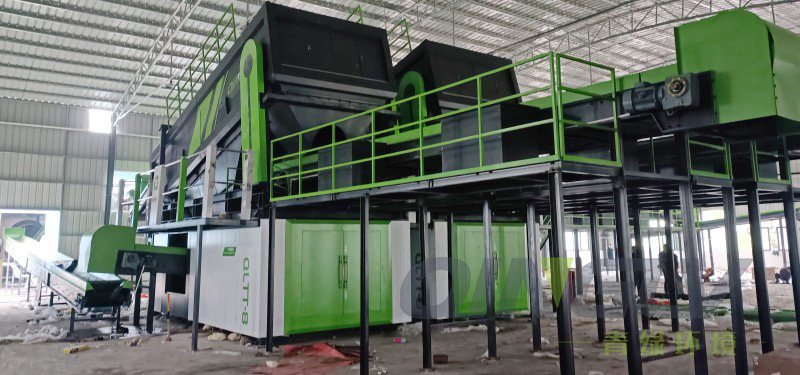 Time:2025-03-31
Time:2025-03-31
 Source:青绿环境
Source:青绿环境
In today's society, with the acceleration of urbanization and the continuous growth of the population, the volume of waste generated has increased dramatically, placing significant pressure on the environment. Waste sorting, as a key measure to address this issue, is of great importance and necessity. It not only helps protect the environment by reducing pollution to soil, water sources, and air but also enables the recycling and reuse of resources, turning waste into valuable assets and promoting sustainable development. Waste sorting equipment, as an essential support for the implementation of waste sorting policies, is an indispensable tool for achieving waste sorting goals.

Types of Equipment
The market offers a wide variety of waste sorting equipment, which can be categorized by processing scale into large - scale, medium - scale, and small - scale devices. Large - scale equipment is typically used in centralized waste treatment facilities, capable of efficiently processing large volumes of waste with high - capacity and high - automation levels. However, they are bulky and costly. Medium - scale equipment is suitable for waste - generating areas of medium size, such as communities and commercial districts, offering a balance between processing efficiency and flexibility. Small - scale devices are commonly found in households and small - scale office settings, characterized by their compact size, ease of operation, and convenience for users to conduct preliminary waste sorting.
Equipment can also be divided into single - function and multi - function sorting devices based on functionality. Single - function devices focus on a specific sorting task, such as magnetic separators for metal sorting and color sorters for selecting objects of specific colors. These devices have strong specificity and high sorting accuracy but are limited in function. Multi - function integrated sorting equipment combines multiple sorting technologies and can handle different types of waste simultaneously. For example, devices integrating magnetic, air, and photoelectric sorting functions can sort multiple types of waste in one go, improving efficiency. However, they tend to have more complex structures and potentially higher maintenance costs.
Core Components and Innovative Technologies
The core components of waste sorting equipment include conveyor belts, sorting claws, and sensors. Conveyor belts transport waste smoothly to various sorting areas and need to be made of materials with high strength, wear - resistance, and corrosion - resistance to ensure long - term stable operation. Sorting claws are the key components that perform the sorting actions. Depending on the sorting requirements, their shapes, sizes, and materials vary. For instance, sorting claws made of wear - resistant alloy can accurately grasp waste of various shapes. Sensors act as the "eyes" of the equipment, detecting various characteristics of waste. Infrared sensors can detect the position and shape of waste, while metal sensors identify metallic substances. These precise sensing technologies provide accurate information for the sorting process.
Innovative technologies are constantly emerging in equipment manufacturing. The application of new - type wear - resistant materials has significantly extended the service life of key components, reducing equipment maintenance frequency and costs. For example, the use of ceramic - coated materials on conveyor belt surfaces has greatly enhanced their wear - resistance. More efficient power transmission systems make equipment operation smoother and reduce energy consumption. Motors with variable - frequency speed control technology can automatically adjust their speed according to actual workload, improving energy - use efficiency. Additionally, the development of intelligent control systems has made equipment operation more convenient and precise. Operators can easily set parameters through human - machine interfaces, monitor equipment status in real - time, and achieve remote control and fault diagnosis.
Cost - Benefit Analysis
In terms of equipment purchase costs, there is a significant price difference among different types of waste sorting equipment. Large - scale, multi - functional devices equipped with advanced technologies are more expensive, potentially costing hundreds of thousands or even millions of yuan. In contrast, small - scale, single - function devices are relatively cheaper, generally ranging from several thousand to tens of thousands of yuan. Regarding operational and maintenance costs, energy consumption is a major expenditure. Large - scale equipment, due to its high processing volume and long - term operation, has relatively high energy consumption. Small - scale devices have lower energy consumption, but their unit processing costs may be relatively higher. Replacement of wear - and - tear parts is also part of the operational costs. Key components such as conveyor belts and sorting claws will wear out over long - term use and need to be replaced regularly. High - quality wear - and - tear parts, although more expensive, have longer service lives and can reduce replacement frequency.
However, from a long - term economic perspective, the benefits of using waste sorting equipment are significant. On the one hand, the increased value of resource recycling is an important economic return. Effective sorting allows recyclables such as metals, plastics, and paper to be fully recycled and reused. These recycled resources have certain economic value in the market, bringing additional income to enterprises or society. On the other hand, the reduction in processing costs should not be overlooked. After waste sorting, the difficulty and cost of subsequent waste treatment processes can be reduced, such as reduced space occupation of landfill sites and lower energy consumption for incineration treatment. In the long run, this greatly reduces the overall cost of the waste - handling system.
Industry Trends and Development Directions
The waste sorting equipment industry currently faces some challenges. High costs are a major issue, especially for small and medium - sized enterprises or emerging waste - sorting projects. The high equipment purchase and maintenance costs limit their widespread application. Additionally, there are compatibility issues with equipment. The composition of waste from different regions and sources is complex and diverse, and existing sorting equipment may not effectively adapt to all types of waste - handling needs in some cases.
Looking to the future, the waste sorting equipment industry shows clear development trends. Integration will be an important direction, combining multiple sorting technologies and functions into compact and efficient equipment systems. This can meet diverse sorting needs while saving space and costs. Green development is also a focus, with the research and development of more environmentally friendly and energy - efficient equipment becoming mainstream. For example, equipment driven by renewable energy sources and with reduced noise and dust emissions. Meanwhile, with the continuous maturation of emerging technologies such as the Internet of Things and big data, waste sorting equipment will be deeply integrated with them. Through the Internet of Things technology, equipment can achieve remote monitoring and management, uploading real - time operation data. With the help of big data analysis, sorting algorithms can be optimized to improve sorting accuracy and efficiency. Intelligent scheduling and predictive maintenance can be carried out based on the patterns and characteristics of waste generation, thus promoting the waste sorting equipment industry to move towards intelligence and high - efficiency, and making a greater contribution to global environmental protection and sustainable resource utilization.













 Prev
Prev











